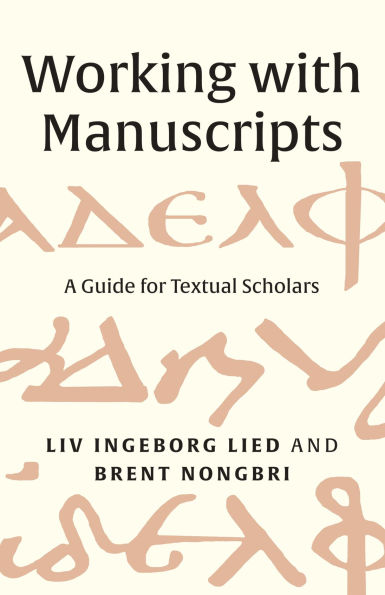A first-of-its-kind handbook outlining best practices and common pitfalls for students and textual scholars interested in beginning to work with manuscripts
While manuscripts are rare in most of the world today, they were once ubiquitous. Before the printing press, literature was preserved and transmitted through handwritten copies containing variant readings, mistakes, corrections, and other unique features. Those who study premodern texts, however, often use as their primary sources not these diverse artifacts but critical editions that present a single convenient hybrid text.
Brent Nongbri and Liv Ingeborg Lied argue that knowledge of manuscripts is important for all interpreters of ancient texts, even if learning how to study them can be confusing and intimidating. In this book they draw on their decades of experience with Jewish and Christian manuscripts to demystify manuscript work. Combining their interests in manuscripts as material artifacts with the ethical issues surrounding the study of manuscripts, Lied and Nongbri guide students through the main phases of research, from considerations of provenance and access to the practicalities of on-site research, analysis, and publication. The book includes aids for locating manuscripts, helpful case studies, tips for organizing data, a glossary, suggestions for further reading, and more.
Written in an engaging style with students in mind, this handbook provides an invaluable resource for anyone who wants to study a manuscript for the first time.
1146064491
While manuscripts are rare in most of the world today, they were once ubiquitous. Before the printing press, literature was preserved and transmitted through handwritten copies containing variant readings, mistakes, corrections, and other unique features. Those who study premodern texts, however, often use as their primary sources not these diverse artifacts but critical editions that present a single convenient hybrid text.
Brent Nongbri and Liv Ingeborg Lied argue that knowledge of manuscripts is important for all interpreters of ancient texts, even if learning how to study them can be confusing and intimidating. In this book they draw on their decades of experience with Jewish and Christian manuscripts to demystify manuscript work. Combining their interests in manuscripts as material artifacts with the ethical issues surrounding the study of manuscripts, Lied and Nongbri guide students through the main phases of research, from considerations of provenance and access to the practicalities of on-site research, analysis, and publication. The book includes aids for locating manuscripts, helpful case studies, tips for organizing data, a glossary, suggestions for further reading, and more.
Written in an engaging style with students in mind, this handbook provides an invaluable resource for anyone who wants to study a manuscript for the first time.
Working with Manuscripts: A Guide for Textual Scholars
A first-of-its-kind handbook outlining best practices and common pitfalls for students and textual scholars interested in beginning to work with manuscripts
While manuscripts are rare in most of the world today, they were once ubiquitous. Before the printing press, literature was preserved and transmitted through handwritten copies containing variant readings, mistakes, corrections, and other unique features. Those who study premodern texts, however, often use as their primary sources not these diverse artifacts but critical editions that present a single convenient hybrid text.
Brent Nongbri and Liv Ingeborg Lied argue that knowledge of manuscripts is important for all interpreters of ancient texts, even if learning how to study them can be confusing and intimidating. In this book they draw on their decades of experience with Jewish and Christian manuscripts to demystify manuscript work. Combining their interests in manuscripts as material artifacts with the ethical issues surrounding the study of manuscripts, Lied and Nongbri guide students through the main phases of research, from considerations of provenance and access to the practicalities of on-site research, analysis, and publication. The book includes aids for locating manuscripts, helpful case studies, tips for organizing data, a glossary, suggestions for further reading, and more.
Written in an engaging style with students in mind, this handbook provides an invaluable resource for anyone who wants to study a manuscript for the first time.
While manuscripts are rare in most of the world today, they were once ubiquitous. Before the printing press, literature was preserved and transmitted through handwritten copies containing variant readings, mistakes, corrections, and other unique features. Those who study premodern texts, however, often use as their primary sources not these diverse artifacts but critical editions that present a single convenient hybrid text.
Brent Nongbri and Liv Ingeborg Lied argue that knowledge of manuscripts is important for all interpreters of ancient texts, even if learning how to study them can be confusing and intimidating. In this book they draw on their decades of experience with Jewish and Christian manuscripts to demystify manuscript work. Combining their interests in manuscripts as material artifacts with the ethical issues surrounding the study of manuscripts, Lied and Nongbri guide students through the main phases of research, from considerations of provenance and access to the practicalities of on-site research, analysis, and publication. The book includes aids for locating manuscripts, helpful case studies, tips for organizing data, a glossary, suggestions for further reading, and more.
Written in an engaging style with students in mind, this handbook provides an invaluable resource for anyone who wants to study a manuscript for the first time.
25.0
In Stock
5
1

Working with Manuscripts: A Guide for Textual Scholars
192
Working with Manuscripts: A Guide for Textual Scholars
192Related collections and offers
25.0
In Stock

Product Details
| ISBN-13: | 9780300281477 |
|---|---|
| Publisher: | Yale University Press |
| Publication date: | 04/15/2025 |
| Sold by: | Barnes & Noble |
| Format: | eBook |
| Pages: | 192 |
| File size: | 14 MB |
| Note: | This product may take a few minutes to download. |
About the Author
From the B&N Reads Blog
